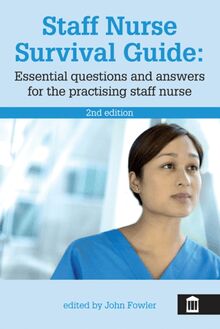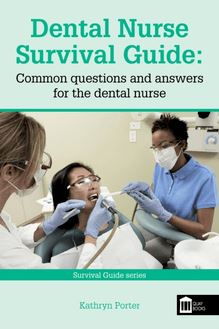Dental Nurse Survival Guide , livre ebook
62
pages
English
Ebooks
2015
Vous pourrez modifier la taille du texte de cet ouvrage
Obtenez un accès à la bibliothèque pour le consulter en ligne En savoir plus
Découvre YouScribe et accède à tout notre catalogue !
Découvre YouScribe et accède à tout notre catalogue !
62
pages
English
Ebooks
2015
Vous pourrez modifier la taille du texte de cet ouvrage
Obtenez un accès à la bibliothèque pour le consulter en ligne En savoir plus
Publié par
Date de parution
10 novembre 2015
Nombre de lectures
1
EAN13
9781856424608
Langue
English
Title page
Dental Nurse Survival Guide
byKathryn Porter
Publisher information
2015 digital version by Andrews UK Limited
www.andrewsuk.com
Quay Books Division, MA Healthcare Ltd,
St Jude’s Church, Dulwich Road, London, SE24 0PB
© MA Healthcare Limited 2011, 2015
All rights reserved. No part of this publication may be reproduced, stored in a retrieval system or transmitted in any form or by any means, electronic, mechanical, photocopying, recording or otherwise, without prior permission from the publishers
Cover design by Louise Cowburn, Fonthill Creative
Associate Publisher: Thu Nguyen
Series editor
Dr John Fowler
Note
Healthcare practice and knowledge are constantly changing and developing as new research and treatments, changes in procedures, drugs and equipment become available.
The author and publishers have, as far as is possible, taken care to confirm that the information complies with the latest standards of practice and legislation.
About the author
Kathryn (Kathy) Porter recently retired from dental nursing in 2011 having started her training in September 1968 at Birmingham Dental Hospital and qualifying in 1970. Apart from a short time working in the dental department of a large industrial complex, she has worked at Birmingham Dental Hospital until her retirement. She was appointed Senior Dental Nurse in 1973 and promoted to Assistant Principal Dental Nurse in 1989. In 2007 her job title changed to Senior Dental Nurse (Decontamination).
Kathy trained as an Infection Control Link Nurse, now known as Infection Prevention and Control Link Practitioner, in 2003 and this began her keen interest in infection control and decontamination good practice. After being invited to sit on the Editorial Board of Dental Nursing in 2005, Kathy began to write articles on the subject of infection prevention and control and was also invited to write a book The Dental Nurses’ Guide to Infection Control and Decontamination which was published in 2008. Although published before the notorious Health Technical Memorandum 01-05 , her book proposes the same, and even higher standards, than those outlined in the HTM 01-05 document, and has become recommended for all dental nurses and dental care professionals (DCPs) as a point of reference on the topic. Kathy has given talks on the subject in various venues to provide verifiable continuing professional development for all DCPs.
Kathy intends to enjoy her retirement, pursuing her interests in travelling, watching Wimbledon, investigating her family tree and generally enjoying being ‘a lady that lunches’, and fully enjoy the freedom after 42 years of full time work.
Introduction
Gaining your qualification and becoming registered is just the start for any Dental Nurse or Dental Care Professional (DCP).
You have learnt all that theory and gained practical experience and you are now a qualified and registered DCP. Suddenly you are expected to know what to do in any situation. Where do you go for advice? What do you turn if you need answers immediately?
This Survival Guide Series aims to be the resource that will help answer those questions. It is designed to be small, with short brief answers to some questions and scenarios which will give immediate help.
I have tried to cover the most common situations but I am sure that I have missed some but hopefully these will be the exception rather than the rule. What is important is that you do not do anything outside your scope of practice and experience. The General Dental Council (GDC) has produced a Scope of Practice for DCP’s which sets out what DCP’s can, and cannot, do in professional practice. You should be fully conversant with these and should not undertake any duty or practice which falls outside this scope no matter who asks you to do so.
It is a fact that there is no substitute for experience and as you gain this experience, the problems and scenarios in this book will become routine, however there will be more to take their place.
Newly qualified nurses should not be embarrassed to ask their more experienced colleagues for help. Any experienced nurse will be only too happy to pass on their knowledge. Dentistry is about working as a team and the role of dental nurses are central to this. No dental practice or facility can work without a good team of dental nurses.
References:
General Dental Council (2008) Scope of Practice for Dental Care Professionals
Section 1: Clinical Practice
Chapter 1: Dealing with medical emergencies What should I do in a medical emergency? What drugs and equipment should the practice have available for medical emergencies? What should I do to avoid a medical emergency? What should I do when an emergency occurs? What are the common medical emergencies I might encounter? What are the more serious but infrequent emergencies I might encounter? What should I do in specific emergencies? Where can I get more information?
What should I do in a medical emergency?
It is important to recognise that serious medical emergencies are a rare occurrence in the dental surgery. However, this does not mean that the possibility should be ignored.
It is essential that all staff in the practice, not just the clinical staff, are aware of what to do if an emergency arises. It would be good practice to hold regular drills in the procedure to follow, which should include all the practice staff - dentists, dental nurses, reception staff, practice manager and hygienist if working onsite. It would be advisable for one person to be designated to take responsibility for ensuring that all emergency equipment, particularly drugs, are in date and in good condition. There must be emergency drugs available in every practice which are kept readily available in an emergency. There should also be at least one full oxygen cylinder; it would be better to have two so that there is a backup if one runs out. It would also be advisable to have a Automated External Defibrillator (AED) available. If the practice regularly carries out treatment under sedation, then a pulse oximeter, the machine routinely used to monitor a patients’ pulse and oxygen saturation, should already be on site. Some more sophisticated monitors can also record electrocardiograms (ECG) for heart conditions.
What drugs and equipment should the practice have available for medical emergencies?
Listed below are the essential types of drugs the practice should have available to deal with emergencies. Further information can be obtained from the British National Formulary (BNF).
Glyceryl trinitrate (GTN) spray – 400 micrograms per dose
This should be available for any patient who is being actively treated for angina. The patient should always carry their own but there are occasions when they forget and it should be available if the patient has an attack.
Salbutamol inhaler - 100 micrograms per actuation
This is a non specific inhaler that can be used by any asthmatic who has an attack requiring medication and does not have their own inhaler available. It can also be given to a patient who has respiratory distress but is not a diagnosed asthmatic or someone who is experiencing an anaphylactic attack.
Adrenaline injection - 1:1000 1 milligram per millilitre
For use by a trained practitioner for a patient who is having an anaphylactic shock.
Aspirin dispersible - 300 micrograms
Can be given to a patient suspected of having a myocardial infarction.
Glucagon injection - 1 milligram
Used in the treatment of unconscious hypoglycaemia.
Oral glucose solution - tablets, gel or powder
For a conscious diabetic having a hypoglycaemic attack.
Midazolam - 10 microgram per millilitre (buccal or intranasal)
To be administered by a trained professional to a patient having a prolonged epileptic attack.
Other equipment that should be available for medical emergencies include:
Oxygen cylinders : For administration to any patient having a medical emergency.
Blood pressure machine : To check blood pressure of a patient having a suspected cardiac incident.
Automated External Defibrillator (AED): To be used by trained personal to a patient who has suffered a cardiac arrest and the heart has stopped beating.
Blood glucose monitor : To check blood glucose levels of a patient suffering a hypoglycaemic attack and to monitor recovery after administering glucose.
Pulse oximeter (If sedation is carried out in the practice): To monitor heart rate and oxygen saturation and with more sophisticated models monitoring electro cardiac activity.
What should I do to avoid a medical emergency?
It is essential that a detailed medical history is taken, checked at every visit and updated as necessary for every patient. This will give warning of known conditions and medication that should be taken, i.e. patients with known angina should always carry their own GTN spray which can be kept at hand during treatment; diabetic patients can be given a glucose drink if they haven’t eaten for a while. Known allergies can also help to forestall anaphylactic incidents i.e. known latex allergy.
All dental professionals are required to complete 10 hours of verifiable Continued Professional Development (CPD) within each 5 year cycle on the subject of Medical Emergencies and Cardiopulmonary Resuscitation (CPR). It would be ideal to include all practice staff in this training and it is possible to have onsite training. Although this may cost more, it would provide a more pertinent training situation and could be used to refine the practice policies and procedures. If one member of staff is designated as having responsibil

